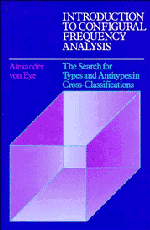 Introduction to Configural Frequency Analysis
Introduction to Configural Frequency Analysis from Part II - Applications and strategies of CFA
Published online by Cambridge University Press: 04 August 2010
Zero order CFA
Zero order CFA (Lienert and von Eye 1984a, 1985; von Eye and Lienert, in press) is applied to determine if there are effects in a given data set. To answer this question, expected frequencies are estimated under the following assumptions:
(1) There are no main effects; the variables under study are distributed according to a joint uniform sampling distribution.
(2) There are no interactions; the variables under study are totally independent.
In other words, zero order CFA assumes no effects whatsoever in the contingency table under study. Deviations from an overall uniform distribution are assumed random in nature. Therefore, zero order CFA can be viewed as an omnibus test sensitive to any kind of effect. Types in zero order CFA indicate that main effects, interactions, or both have led to agglomerations of cases in certain configurations. These agglomerations are similar to clusters of cases that are identified with, for example, Ward's (1963) method. Both CFA and Ward's method define clusters as spatially close cases. Both methods identify agglomerations of cases without reference to underlying main effects or interactions of variables. Because of this, zero order CFA is also called configural cluster analysis, and zero order types are called clusters. Accordingly, anticlusters indicate relatively sparsely frequented sectors of the data space that are due also to main effects or interactions.
To save this book to your Kindle, first ensure [email protected] is added to your Approved Personal Document E-mail List under your Personal Document Settings on the Manage Your Content and Devices page of your Amazon account. Then enter the ‘name’ part of your Kindle email address below. Find out more about saving to your Kindle.
Note you can select to save to either the @free.kindle.com or @kindle.com variations. ‘@free.kindle.com’ emails are free but can only be saved to your device when it is connected to wi-fi. ‘@kindle.com’ emails can be delivered even when you are not connected to wi-fi, but note that service fees apply.
Find out more about the Kindle Personal Document Service.
To save content items to your account, please confirm that you agree to abide by our usage policies. If this is the first time you use this feature, you will be asked to authorise Cambridge Core to connect with your account. Find out more about saving content to Dropbox.
To save content items to your account, please confirm that you agree to abide by our usage policies. If this is the first time you use this feature, you will be asked to authorise Cambridge Core to connect with your account. Find out more about saving content to Google Drive.